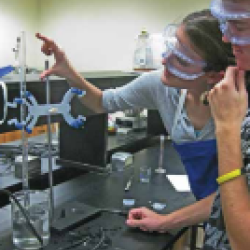Source Institutions
Source Institutions
Add to list Go to activity
Activity link broken? See if it's at the internet archive

The objective of this inquiry-based lesson is for learners to gain an understanding of how increasing ocean acidity can affect the calcification of marine organisms. During this activity, learners: (1) design an experiment to quantify the CaCO3 concentration of two invertebrate skeletal samples, one that has been soaked in normal seawater and another in a low pH solution, and (2) use critical thinking and discussion to evaluate possible explanations for the difference in the skeletal CaCO3 compositions. This lesson plan includes a post-activity demonstration, which shows how the dissolution of CO2 into the ocean lowers pH.
- 4 to 24 hours
- 2 to 4 hours
- Over $20 per group of students
- Ages 14 - adult
- Activity, Experiment/Lab Activity, Lesson/Lesson Plan
- English
Quick Guide
Materials List (per group of students)
- Organism information table (Table 1)
- Samples of cuttlefish bone, coral, and shells from crab, shrimp, clam, mussel, snail, and oyster.
- Gloves, goggles, aprons
- Vinegar (or dilute HCl) for instructor to prepare “low pH condition” samples
- HCl (3 M solution)
- Thin-stem pipettes (~ 4 ml)
- Electronic balance (precision of ± 1 mg)
- Mortar and pestle
- Beakers of various sizes (50 ml, 250 ml)
- Graduated cylinders (10 ml, 50 ml)
- Fume hood
- Watch glasses
- Balloons
- Drying paper
- Rubber spatula
- Stirring rod
- Filter paper and weigh paper
- Funnel
- Clear plastic cups
- Straws
- Freshwater pH indicator solution (for aquarium) with color pH scale
- Tap water
Subjects
-
Earth and Space Science
-
Earth Structure
- Oceans and Water
-
Earth Structure
-
Life Sciences
-
Diversity of Life
- Animals
-
Ecology
- Ecosystems
- Populations
- Human Impact
-
Diversity of Life
-
Physical Sciences
-
Chemistry
- Chemical Reactions
- Acids and Bases
- Chemistry of Life
-
States of Matter
- Gases
-
Structure and Properties of Matter
- Mass and Weight
-
Chemistry
-
The Nature of Science
-
Science and Society
- Risks and Benefits
-
The Scientific Process
- Asking Questions
- Conducting Investigations
- Gathering Data
- Formulating Explanations
- Communicating Results
-
Science and Society
Informal Categories
- Animals
- Nature and Environment
Audience
To use this activity, learners need to:
- see
- see color
- read
- touch
Learning styles supported:
- Involves teamwork and communication skills
- Involves hands-on or lab activities
Other
Access Rights:
- Free access
By:
- Boleman, Casey L. ; Gravinese, Philip M. ; Muse, Ellen N. ; Marston, Andrea E. ; Windsor, John G.
Rights:
- All rights reserved, The Oceanography Society, 2013
